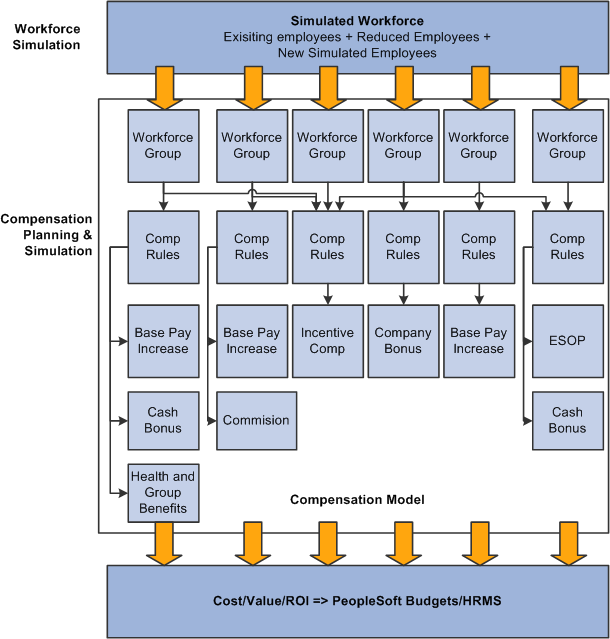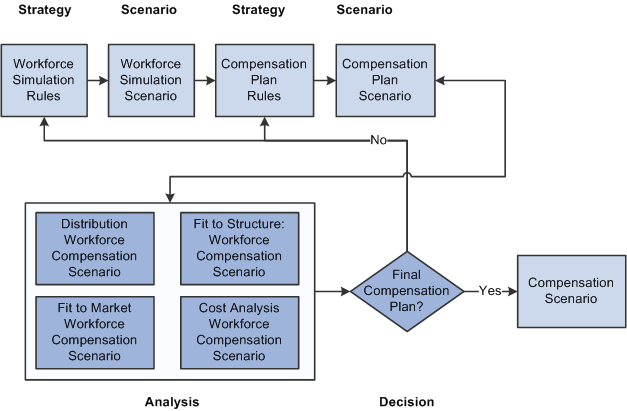Understanding Compensation Strategy
This section provides an overview of the Workforce Rewards Compensation Strategy and discusses:
Compensation strategy definition
Compensation Strategy business process
Market compensation rates
Overview
The Compensation Strategy module provides tools to review and analyze the total compensation costs and strategies for your workforce. With Compensation Strategy you can automate and streamline the performance of these compensation strategy tasks:
Use data extracted from multiple sources.
Define compensation rules for any type of compensation, such as base pay, variable compensation, or benefits compensation.
Create scenarios of your organization's job growth and reduction, or headcount plans.
Create and analyze multiple compensation scenarios involving combinations of compensation types, such as base pay, variable compensation, and benefits compensation.
Evaluate the impacts of these scenarios on compensation distribution, costs, and value.
Once you've identified the scenarios with the desired results, approve the results of your efforts.
You also utilize a wealth of data in the process. Compensation Strategy integrates data from a variety of sources, such as:
Workforce compensation data from internal transactional database systems, such as HRMS.
Market rates developed with the Market Compensation module.
Base pay structures developed with the Base Pay Structure module.
Employee retention and reduction data from the Retention Strategy module.
Key performance indicators (KPIs) from Scorecard and Workforce Scorecard.
You use the Compensation Strategy module to generate differing scenarios of base and variable compensation plans, as well as any other cost-related plans (such as benefits). We designed the module around two main Application Engine processes, Workforce Simulation (WA_WFS) and Compensation Planning & Simulation (WA_CPS).
Image: Conceptual relationship between Workforce Simulation and Compensation Planning and Simulation
This diagram illustrates the conceptual relationship between Workforce Simulation and Compensation Planning and Simulation.

Compensation Strategy Definition
Before you begin using the Compensation Strategy module, take some time to formulate the questions that you want to answer. The types of questions to consider fall into two broad categories:
What is your organization's overall compensation strategy? What changes in the existing compensation system would you like to model, to assess their effects?
How can you best use Compensation Strategy to generate scenarios to evaluate and answer these questions?
One part of understanding your organization's compensation strategy involves knowing what pay components, target pay rates, and pay ranges to apply to various jobs. It also involves understanding your organization's ongoing efforts to attract and retain the right people with the necessary skill levels. Once you have this background you are ready to use Compensation Strategy to perform tasks such as:
Model the changes from a proposed salary or compensation reorganization, based on market values, to evaluate the cost of moving your workforce up to market levels.
Create new types of variable compensation to help motivate your workforce, and evaluate the cost impact.
Target special compensation plans for specific groups of employees, such as executives, salespeople, or workers with mission-critical job skills.
A second part of understanding your organization's compensation strategy involves knowing how the overall compensation strategy cycle is executed, and knowing at what point in the cycle your organization is at a any given time. Equipped with this knowledge, you can use Compensation Strategy to perform these types of tasks:
Model compensation cost changes based on forecasted workforce growth and reduction.
Establish a merit matrix or other rules for pay out of annual base pay increases.
Determine what types of performance goals or related pay out rules you need for any base compensation or variable compensation types in the compensation plan.
Examine the compensation cost effects based on organizational performance indicators, for periodic bonuses and so on.
Set proposed compensation budgets for departments or business units.
Allocate compensation pools across organizations, special classifications, groups, and individuals.
Another part of your strategy involves understanding how to best use Compensation Strategy. You have these options:
Set up and run Compensation Planning and Simulation (CPS) as a Historical process, using your existing workforce. This means having no inputs from Workforce Simulation.
Set up and run CPS as a Forecast process, using input from Workforce Simulation, or Retention Strategy, or both, to include simulated changes to your workforce in the scenarios. Follow the retention or workforce simulation results through the completion of the CPS process, and evaluate the cost impacts of your retention, growth, and reduction decisions.
Set up and run CPS with or without including existing base salary in the compensation rules. This means you can either evaluate the total compensation impact of a scenario, or focus only on the change introduced by new rules.
Compensation Strategy Business Process
Image: Compensation Strategy business process
The following diagram outlines the main steps in the Compensation Strategy business process.

Market Compensation Rates
If you plan to use market rates to help you develop and evaluate compensation scenarios for your workforce, make sure you have completed the steps needed to import compensation survey data, and define market compensation rates.
If you plan to use new base pay structures to help you develop and evaluate compensation scenarios for your workforce, make sure you have completed the steps needed to develop new base pay structures.